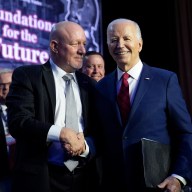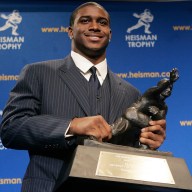With UMass football moving up from D-1AA (FCS) to D-1 (FBS) this season and playing all of their home games at Gillette Stadium, they will begin the transition to “big-time” college football.
Numerous programs have made the transition to the FBS with no problems, and dramatically increased their attendance. The most notable school doing such was UConn, which moved into the FBS in 2002 and then began playing their home games at Rentschler Field in East Hartford during the 2003 season.
UMass doesn’t want to be like UConn and other schools, however. Rather, they’d like to set a new standard.
“We are very unique,” said Jason Blanchette, UMass’ Director of Sales to Metro Boston. “One of the challenges is that we are playing an hour and 45 minutes away from campus. You can’t really compare that to any other school. We are trying to put our own UMass flair to everything. We are not trying to be anyone else, we are just trying to be UMass.”
Prior to UConn’s upgrade, it played its home games on campus at Memorial Stadium and averaged 15,085 fans per game. The new stadium was a 25-minute drive from campus, but the program saw a dramatic attendance increase.
In 2003, the Huskies averaged 37,059 fans per game in a stadium that has a capacity of 40,000. They sold out two of their six home games that year, including the first home game against Indiana. Coincidently, UMass will open its FBS and Gillette Stadium era against Indiana on Sept. 8.
Last season, playing their home games on campus at McGuirk Alumni Stadium the Minutemen averaged 10,004 fans per game. This is a number that will need to be increased to meet goals and a standard set by the NCAA.
“Obviously our goal right now is we need to meet the NCAA rules for transition average which is 15,000 per home game this season,” Blanchette said. “That obviously is our minimum goal, but we’d like to exceed that. We would love to get 30 or 35,000 to that first Indiana game. … We want to make sure when [fans] are there it will leave a lasting impression so they will come back for another game.”
With the Amherst campus being an hour and 45 minutes away from Gillette Stadium, attracting students could prove to be difficult, but Blanchette says it shouldn’t be a problem.
“Our students are excited,” he said. “I think they look at playing all of our home games at Gillette Stadium as one of the best college football venues in the country. A lot of students will make a weekend out of it. They have a lot of friends going to BC, BU and Northeastern, so they will get in the car and head out. We are also offering the opportunity for students to take a bus.
“They are excited about going to see top-level college football against teams like Indiana in the Big 10. We have never had that in the past so they are really excited about it. I think especially that first game we will see a great student crowd.”
Alumni will also play a major role in just how much the school will exceed their goals in terms of attendance as they have been a major target for ticket sales.
“I am not sure of the exact number, but 100,000 or so are located within the Route 495 corridor,” Blanchette said. “The alumni association has been a big help to get some promotions out at various events. We’re continuing to reach out to alumni because they are very important to us, especially with the mass volume of alumni in the Boston area. We have received tremendous feedback from them. A lot of alumni are going to be doing their own tailgates the days of games and we are going to have the CBS Scene be the UMass Alumni fan spot for everyone to meet and have a good time.”
The biggest obstacle so far, according to Blanchette, has been UMass fans, and Western Massachusetts natives not being used to football being promoted so early.
“With the whole move to the FBS and the MAC we have needed to be more proactive in selling tickets earlier, and our advertising has needed to be out there earlier,” Blanchette said. “Especially in Western Mass., the people are not used to the football season starting so early, so I think people were a little confused, but now that we are a couple of weeks out people are starting to realize it is football season. The challenge has been getting people in that football mindset mode a little earlier than they are used to in the past.”
With all the challenges set with such a major move, the administrators can only do so much. Much of what determines whether or not fans will continuously come out and support the program comes down to the play on the field.
If the team gets blown out on a week-to-week basis there will be no support, but if the team stays competitive and wins a few games, the fans will be there and the attendance numbers will show.
The first home game against Indiana of the Big 10 will be their biggest test of the year. It could have a significant impact as to what the remainder of the season will bring.















